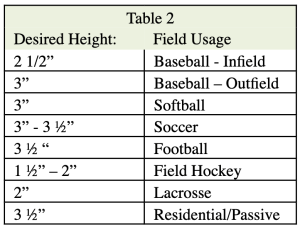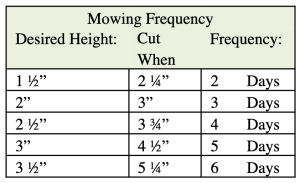Mowing is one of the basic foundations for creating a healthy lawn. Unfortunately, this practice is often mismanaged on residential lawns and athletic fields. Dial in proper mowing protocol this summer and see results.
Reduce Stress on Turf
Firstly, it is important to realize that mowing causes stress to the turf grass. Mowing removes tissue from the grass blade that would otherwise undergo photosynthesis. During photosynthesis, the chlorophyll in grass blades capture energy from sunlight and use it to convert carbon dioxide and water into glucose and oxygen. Then, glucose is stored in the plant’s cells and used as a source of energy. As a result, mowing reduces the energy store for the grass plant.
To minimize stress on your lawns and fields, reference these 7 guidelines for summer mowing.
1. Mowing Height
 Turf height requirements for athletic fields are different from residential lawns. An athletic field’s function and season both impact the height of cut. Given a lacrosse ball is significantly smaller than a soccer ball, they do not each require a field to be maintained at 2″ HOC. In addition, a lacrosse field that is played on in March and April should not be maintained at 2″ all year, when football or soccer is going to be played on it in September. For high traffic athletic fields, it may be necessary to maintain grass at a slightly higher HOC to better withstand wear and tear. Residential lawns may be maintained at 3 – 3 ½″ throughout most of the season. During extreme heat, consider maintaining a HOC of 4″. Final cut of the season should be at 2 ½″.
Turf height requirements for athletic fields are different from residential lawns. An athletic field’s function and season both impact the height of cut. Given a lacrosse ball is significantly smaller than a soccer ball, they do not each require a field to be maintained at 2″ HOC. In addition, a lacrosse field that is played on in March and April should not be maintained at 2″ all year, when football or soccer is going to be played on it in September. For high traffic athletic fields, it may be necessary to maintain grass at a slightly higher HOC to better withstand wear and tear. Residential lawns may be maintained at 3 – 3 ½″ throughout most of the season. During extreme heat, consider maintaining a HOC of 4″. Final cut of the season should be at 2 ½″.
2. Transition Mowing Height

Cutting your grass too short can weaken the turf and make it more susceptible to stress, diseases, and weeds. Don’t remove more than one third of the grass height in a single mowing. Do not trust the settings on the mower deck to accurately reflect the actual height of cut (HOC). Keep in mind that tire pressure and weight of the operator (if it’s a ride-on mower) will affect the height of cut. So…measure!
3. Mowing Frequency
Adjust your mowing frequency according to the growth rate of the grass. You may need to mow more frequently during periods of active growth. Conversely, during slower growth periods, you can mow less often. Maintaining a shorter HOC on an athletic field will require more frequent mowing. Typically, weekly mowing is suitable for most residential lawns, especially if a HOC of 3 – 3 ½” is being maintained.
4. Sharpen Mower Blades
Ensure that mower blades are sharp. Dull blades can tear the grass and create an uneven and ragged appearance. Consequently, turf will have a brown cast to it. Cutting with dull mower blades will increase the likelihood of disease, decreased photosynthesis, and increased water loss. Therefore, clean and sharpen blades regularly (minimum every 24 hours) to achieve clean precise cuts.
5. Clipping Management
Leaving grass clippings on the lawn—known as grass cycling—can provide valuable nutrients and organic matter back to the soil. In an organic lawn, grass clippings will not contribute to thatch. Rather, the active, healthy biology in the soil will help it break clippings down. If the clippings are excessive and clump together, consider using a mulching mower, double cutting, or disburse them to avoid smothering the grass.
6. Alternate Mowing Patterns
Be sure to change the mowing pattern each time you mow. This helps prevent soil compaction and ensures an even cut. Vary the direction, such as mowing north→south one week, east→west the next, and on a diagonal the following week.
7. Avoid Mowing in Wet Conditions
Mowing wet grass can lead to uneven cuts and damage the turf. Ideally, mow when the grass is dry to achieve a cleaner cut and minimize soil compaction.
Practical Approach, Proven Products
These are general guidelines to provide a guide to mowing. Also, be sure to consider: usage, site conditions, seasonal variations, and grass types while developing your mowing practice. One size does not fit all when it comes to proper mowing protocol.
PJC emphasizes the importance of combining our practical approach with proven products. Our practical approach is built on well-implemented organic turf care practices, one of which is mowing. Our proven products include all-natural, organic fertilizers and soil amendments. Don’t rely solely on our blogs for information, email us to learn about how we can help you implement organic turf care successfully.
